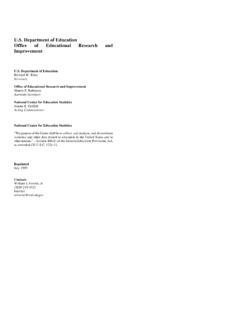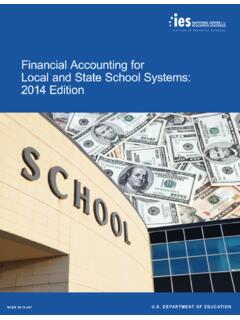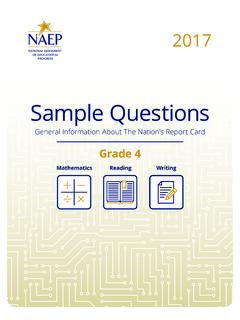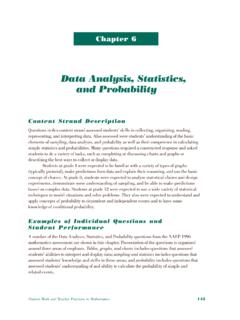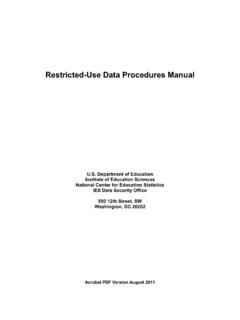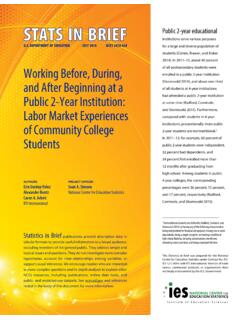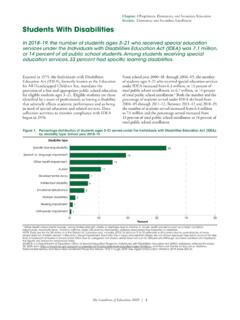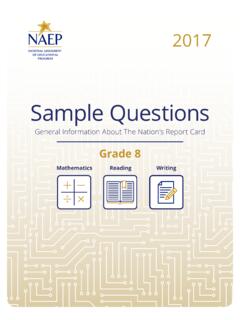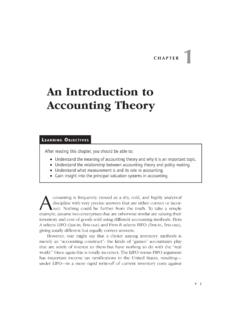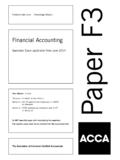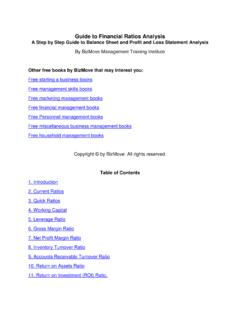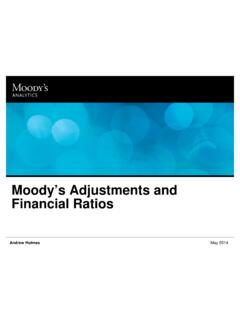Transcription of Chapter 4 Financial Performance Indicators and Measures
1 Chapter 1: IntroductionFinancial Condition and Key ratios Definitions and UsesAnalysis of a school district s Financial condition is generally based on data elements used to construct a series of ratios that depict the short- and long-term district Financial situation. These ratios aid in the interpretation of finance data and are used in Financial statements and reports to compare the relationship between Financial elements. For example, it is difficult to assess whether revenues are sufficient by reviewing revenues alone. Rather, it is more meaningful to compare revenues with another Financial element, such as liabilities or net assets. This produces a measure that is comparable for different fiscal periods for the same entity and among other similar entities. ratios are useful tools for Financial statement analysis because they conveniently summarize data in a form that is more easily understood, interpreted, and possible standards that might be used include: the planned ratio for the period being analyzed; the corresponding ratio during the preceding year, or some average of past years; the corresponding ratio from a peer school district or the state-wide average.
2 And the legislatively mandated benchmark for the components of Financial statements and reports, these ratios are used both internally by the school district to monitor and assess district finances and practices, and externally by legislators, taxpayers, parents, and others who wish to assess aspects of school district Financial statement analysis is directed at the Financial soundness of the district through its ability to provide services in relation to the tax structure, tax base, state and local economic climate, supply and cost of staff and resources, enrollment, and demand for services. Reviewing current and past Financial Indicators in the context of these outside variables can provide some insight into the management decisionmaking process to maintain the solvency of the district. Several states use Financial information to set benchmarks based on multiyear trends of specific Financial Measures that determine whether districts are beginning to experience Financial difficulty, so that internal or external policy actions can be taken to correct the situation.
3 Additionally, rating agencies look at the current and past Financial situation of the school district through a series of Financial Measures that represent a distinct and important composite of district Financial Indicators . Local taxpayers can also use district Financial information to make informed decisions on local tax referenda as well as the need for participation in the local budget approval 4 Financial Performance Indicators and Measures Forum Guide to Core Finance Data ElementsRecently, there has been significant interest nationally in developing Measures of efficiency in the use of resources. This involves linking student achievement with the Financial resources expended to produce the desired academic Performance . This measure is often referred to as Return on Investment, and provides another assessment of school and/or district accountability for following sets of ratios are categorized into major areas and represent some of the more common Financial ratios used (Meade 2001).
4 These ratios can be modified to reflect per pupil or per capita figures, depending on the use of the measure. Some ratios incorporate a period of time and inherently reflect growth or change in the indicator. Others are point-in-time Indicators , but can also be viewed sequentially through time-series analysis. ratios can also be compared between districts through cross-sectional analysis. In either case, care must be taken to ensure the comparability of data either across districts or within the same district over time if major or one-time changes have definitions are presented in broad aggregate terms relating to assets and expenses, and can be further refined to address specific assets and expenses using the same methodology to evaluate a particular Financial category within the school district. For example, Financial position ratios can be based on unrestricted assets, restricted assets, or capital assets, as well as the more general ratio using total assets.
5 Similarly, all definitions can be refined to incorporate particular funds, programs, or revenues. All ratios can also be modified to a per student basis. Basic definitions of accounting and finance terms used can be found in Siegel and Shim (2005) and Downes and Goodman (2006).It should also be noted that no one ratio should be used to evaluate the Financial condition or capacity of the school district. The ratio should be used to identify Financial issues that may require further Condition IndicatorsKey ratios of the Financial condition of a school district assist in evaluating the district s current Financial situation as well as provide insight into the district s ability to continue providing services in the future. In general, these Financial ratios can be categorized as Measures of Financial position, liquidity, solvency, and fiscal Position RatiosFinancial position ratios are used to evaluate the current and past Financial condition of a school district in terms of the nature of its debts and obligations and the resources available to repay PositionThis ratio is used to evaluate a school district s Financial position at a given time based on a comparison of the resources it generally owns or controls with its obligations.
6 It is calculated as:(Assets Liabilities) / Total RevenuesThis measure can be modified to use expenses (net assets divided by total expenses or operating expenses), fund balances (fund balance divided by total expenditures, revenues, or operating revenues), or unreserved fund balance (unreserved fund balance divided by total expenditures, revenues, or operating revenues). Chapter 1: IntroductionChange in Financial PositionA change in Financial position is measured in terms of change in net assets divided by total revenues. This ratio is used to evaluate the change in a school district s Financial position based on a comparison of the resources it generally owns or controls with the obligations it faces. It provides information as to how the Financial position of the school district has changed over time. It is calculated as:(Net Assetse Net Assetsb) / Total RevenueseWhere:b = beginning of time period, ande = end of time indicator can be modified to use expenses (change in net assets divided by total expenses or operating expenses), fund balances (change in fund balance divided by total revenues, operating revenues, or expenditures), or unreserved fund balance (change in unreserved fund balance divided by total revenues, operating revenues, or expenditures).
7 This ratio shows the direction of change in Financial position over a period of time, whereas Financial position is a point-in-time RatiosLiquidity ratios are used to evaluate whether a school district will be able to meet its obligations in the short run and whether it will have sufficient resources to cover ongoing operating RatioThis ratio is used to evaluate a school district s ability to cover its obligations with existing resources. It is calculated as:Current Assets / Current LiabilitiesWhere: Current Assets are defined as cash, accounts receivable, inventory, and other assets that are likely to be converted into cash, sold, exchanged, or expensed in the normal course of business, usually within a year; andCurrent Liabilities are defined as debt or other obligations coming due within a year (Downes and Goodman 2006).Quick RatioThe quick ratio is measured in terms of the sum of cash and current investments divided by current liabilities.
8 This ratio is used to evaluate a school district s ability to meet its current obligations using only the most liquid assets generally cash, near cash assets such as money market funds, other short-term investments, and sometimes receivables. It is calculated as:(Cash + Current Investments) / Current LiabilitiesWhere:Current Investments (short-term investments) are defined as funds placed in securities that are expected to be held for one year or less (Siegel and Shim 2005). Chapter 4: Financial Performance Indicators and Measures Forum Guide to Core Finance Data ElementsSolvency RatiosSolvency ratios are used to evaluate a school district s ability to repay its long-term obligations, such as bonds, or to cover future costs, such as compensated absences and leave pay. Solvency ratios are categorized either as leverage ratios or coverage ratios . Leverage ratios are used to determine the degree to which a school district s assets are financed through borrowing and other long-term obligations.
9 Coverage ratios compare cash flows to a district s debt repayments, both interest and RatioThis ratio is used to evaluate the degree to which a school district has resources necessary to repay its debt. It is calculated as:Total Liabilities / Total AssetsDebt-to-Net-Assets RatioThis ratio is used to evaluate the degree to which available resources for providing public services by the district are financed through debt. It is calculated as:Total Liabilities / Net AssetsTimes-Interest-Earned RatioThis ratio compares cash flows generated by operations to interest payments on debt. It is calculated as:(Cash Flow from Operations + Interest) / InterestWhere: Cash Flow = (General Funds Revenues + Special Funds Revenues General Funds Current Expenditures Special Funds Current Expenditures); andInterest = Interest on Long-Term Debt for Governmental and Business-Type Activities. Debt Service Coverage RatioThis ratio compares cash flows to all debt repayments, both interest and principal.
10 It is calculated as:(Cash Flow from Operations + Debt Service) / Debt ServiceWhere: Debt Service = (Interest on Long-Term Debt for Governmental and Business-Type Activities + Principal Repayments for Long-Term Debt for Governmental and Business-Type Activities).Fiscal Capacity RatiosFiscal capacity ratios measure a school district s ability to generate resources that can be used to finance the provisions of services to students. Many of these Indicators combine a school district s Financial statement information with economic, demographic, and tax-related data. These ratios compare revenues, expenses, and debt to measure the community s ability to pay for school district services. Full-time equivalent student counts are used in many of the following ratios ; however, other Measures of student counts can be substituted. Chapter 1: IntroductionTaxable Property per Student(Total Taxable Property Value) / (Total Full-Time Equivalent Students)Property Tax Revenues per $100 of Assessed Property Value(Total Property Tax Revenues x 100) / (Total Assessed Property Value)Note: This produces an effective tax rate rather than the rate per Student(Total Tax Revenues) / (Total Full-Time-Equivalent Students)Debt per $100 of Assessed Property Value(Total Liabilities x 100) / (Total Assessed Property Value)Debt per Student(Total Liabilities) / (Total Full-Time-Equivalent Students)Revenue and Expenditure AnalysisRevenues and expenditures are two key sets of elements used in the Financial analysis of school districts.
